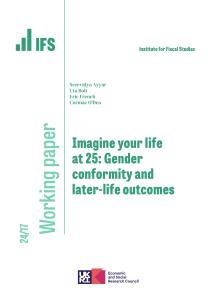The IFS Deaton Review of Inequalities trends in income and wealth inequalities chapter documents how economic inequalities have changed over the last sixty years, and how experiences have varied for different groups.
The chapter emphasises the need to look not only at traditional measures of income inequality, but also at the role of wealth relative to income. It argues that wealth is an increasingly important driver of economic divides in the UK today, with likely implications for social mobility. Here are 5 charts that explain what we have found.
1. Income inequality in the UK increased substantially over the 1980s but has been more stable in recent decades
Since 1961, the evolution of disposable household income[1] inequality in the UK can be divided broadly into four phases, illustrated by Figure 1. The figure shows two measures. One is the 90:10 ratio, which is a measure of the ratio between the 10th percentile and 90th percentile of the income distribution.[2] A higher ratio means more income inequality between those close to the top and those close to the bottom. The other measure shown is the share of total income going to the top 1%.
The first period, lasting through the 1960s up until 1979, saw income inequality remain broadly flat on most measures. The second is the period from 1979 to 1990. This period saw rises in income inequality right across the income distribution, and as a result there was a large increase in both the 90:10 ratio and the share of income going to the top 1%.
Following that, income inequality stabilised across most of the distribution, with the 90:10 ratio actually creeping down until the Great Recession in 2008. However, the very top continued to pull away over this period. Since the Great Recession, patterns of income inequality have changed little, with people experiencing low disposable income growth right across the income distribution.
2. Relative poverty increased sharply in the 1980s but has fallen slowly over the last three decades, driven by falling poverty rates among pensioners
Relative poverty is effectively a measure of inequality between middle-income households and those on low incomes, with the most common measure being the proportion of people with household incomes below 60% of the median. This measure follows a similar path to that of the 90:10, with a large increase in the relative poverty rate during the 1980s, and a subsequent slow decline in the period since.
However, different groups had different experiences, with pensioners seeing a drastic decline from a high of 41% in 1989 to 18% in 2019. Children saw a much more modest decline starting in the early 2000s and partially reversing since 2010, whilst relative poverty for working age adults without children increased from the 1990s until the financial crisis.
3. Income inequality in the UK is high compared to most developed countries
The UK is not alone amongst developed countries in having experienced an increase in income inequality over the last 60 years. But income inequality in the UK has grown more than in most OECD countries. Today the level of UK income inequality is high international standards, as seen in Figure 2, which shows the Gini coefficient – a summary measure of income inequality across the distribution – for OECD countries. Looking beneath that simple summary measure, it turns out that it is largely the degree of inequality between high- and middle- income people that sets the UK apart from many of its comparators.
4. Looking beyond income, growing asset prices are making the old wealthier, but make wealth less attainable for the young
One of the main conclusions from this chapter is that focusing just on income inequality, as is so often done, misses a growing economic dividing line – wealth – which is central to concerns about the relative plight of different generations, and social mobility.
Whilst people across the income distribution have seen their incomes stagnate in recent years, continued growth in asset prices has increased the wealth of those who already hold it. These two facts make it increasingly hard for working families to climb the wealth distribution, as the rungs on the ladder grow wider apart. In 2008, it took 10 years’ worth of typical full-time gross earnings to move from the middle to the top of the wealth distribution. By 2018, this had increased to almost 16 years. Significant growth in asset prices during Covid, as well as higher rates of saving during lockdown amongst richer people, may well have made the gaps between the steps wider still.
A big part of this story is that young generations are much less likely to get on the housing ladder than their predecessors. Figure 4 shows homeownership at different ages for people born in different decades. We can see that those born in the 1970s were less likely to own homes than those born in the 1950s and 1960s were at the same age, and those born in the 1980s were less likely still. For example, only 36% of those born in the 1980s were homeowners by age 30, compared to 55% of those born in the 1970s and over 60% of those born in the 1950s and 1960s. A natural consequence is that wealth is becoming increasingly concentrated amongst older people, whilst half of working-age adults are now renting.
5. The challenge for younger generations is made much greater by the slowdown of earnings and income growth
Those born in recent decades are seeing their incomes grow much less than their predecessors as they age, threatening the previous norm of generation-on-generation increases in income levels. For those born in the 1940s and 1950s, incomes would typically double from their late 20s to their early 50s. However, those born in the 1960s only saw income grow by around 50% over that period, whilst those born more recently look set to see weaker growth still as they age.
This is central to why it is becoming harder to save one’s way up the wealth distribution (see above), and the consequent threat to social mobility. Taking home-ownership as a key example, we can already see that the gap between homeownership rates in the top decile of the income distribution (73% homeowners) and the middle (50% homeowners) and top deciles of the income distribution has never been greater.
The findings in this chapter are another reminder of the need to consider different types of inequalities in a range of different outcomes if the consequences of economic inequality are to be properly understood. Studying the co-evolution of income and wealth together sheds light on how stagnating but unequal incomes and growth in asset prices have interacted to set up a bleak picture for the prospects of future generations. And with the current economic situation potentially pulling back both incomes and asset prices, just after the pandemic saw significant asset price increases, it will be as important as ever to keep monitoring trends in these inequalities.










